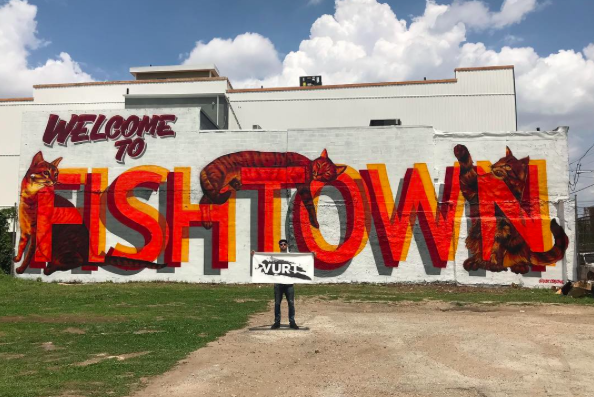
August 02, 2017
 @vurt.creative/Instagram
@vurt.creative/Instagram
Evan Lovett and Glossblack's "Welcome to Fishtown" mural is located at 1140 Frankford Ave.
Fishtown has been a red hot housing market for more than a decade now, in part because of the varied nightlife and amenities and possibly more so because it's been the best neighborhood in the country to turn a profit on a home flip.
The other side of the coin, despite a seeming abundance of nook-and-cranny construction, is that Fishtown as a whole is considered a "tough-to-build" ZIP code, according to a recent analysis published by The Wall Street Journal.
Issi Romem, the economist who conducted the national analysis, explained in a blog for BuildZoom that the reasons a neighborhood becomes resistant to new construction can be counterintuitive. It's not necessarily a lengthy permitting process or stiffer evaluation of proposals from developers that halts expansion.
A better way to gauge the toughest places to build is to ask “where does an increasing willingness to pay for housing fail to result in more housing being built?” If people are willing to pay increasing amounts of money for housing, then a paucity of new homes indicates that construction is obstructed, i.e. that it is a “tough-to-build” area. The obstruction can stem from natural geography, from man-made constraints on what may be built, or – as is generally the case – from a mixture of both.
Why Fishtown would fall into this category comes down to a few general factors Romem found among the places with slowed housing growth.
First, Fishtown falls just outside the realm of downtown Philadelphia, where density is expected and developers can find a friendly commercial atmosphere to make the most of their investments. Projects like East Market and the FMC Tower, where University City is emerging as another downtown, are likely to have a higher concentration of students and professionals within a short distance of their workplaces. Fishtown remains a neighborhood built around the commercial backbone of Girard and Frankford avenues.
The second factor Romem identified is gentrification. When sharp housing price appreciation is a reflection of a neighborhood's physical charm, it becomes more difficult to build new housing that might encroach on the preferences of the community, which in Fishtown has remained fairly balanced and without the contention sometimes seen in Point Breeze and the neighborhoods surrounding University City.
But Fishtown has also become a "tough-to-build" neighborhood because its housing stock grew rapidly from 2000 to 2015. Here's a look at the top five U.S. ZIP codes where the challenges of new construction are at their highest.
Top five “tough-to-build” ZIP codes in the United States.
Just because Fishtown's vacant residential lots are dwindling doesn't mean the neighborhood has hit its limit of growth. FixList Co., the Philly-based real estate data firm, recently published a study of the city's industrially zoned land that could be primed for residential development.
Kensington and the River Wards dominated the list of ZIP codes with the highest number of vacant industrial parcels. Fishtown, at No. 7, has 271 industrial parcels covering 2.1 million square feet of land.
Philadelphia's housing development will need to respond to increasing demand felt in urban areas across the country, where an anticipated 4.6 million new apartments will be required by 2030. About 38,000 units will be necessary to meet the pace of Philadelphia's incoming population by 2030, according to a recent analysis commissioned by the National Multifamily Housing Council.
In the interim, much of the city's housing growth may come in Philadelphia's "middle neighborhoods," which straddle the line between growth and decline. Neighborhoods just west of Fishtown are also, for what it's worth, seeing a boom in new construction.
Even as Philadelphia's job market shows signs of picking up, housing affordability will continue to be a key factor in the city's attractiveness to many job seekers.
Some of that could be dictated by what transpires with the city's surging real estate prices over the past few years—including 22.2 percent growth in the last year alone. If it proves to be a bubble and apartment growth extends as much into industrial lots as it currently is in downtown high-rises, there could be more affordable locations to live within easy access to Philadelphia's destination neighborhoods.
 Source/BuildZoom
Source/BuildZoom